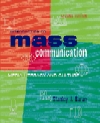|
 |  Introduction to Mass Communication, 2/e Stanley J. Baran
Feature Summary- Emphasis on developing media literacy. Chapter 2 emphasizes the elements of media literacy, and this emphasis is woven throughout the text. Each chapter from Chapter 3 to 15 contains a section, specific to that chapter's medium or issue, on developing media literacy skills.
- Cultural perspective. "The media-either as a forum where important issues are debated, or as storytellers that carry our beliefs and values across people, space, and time-are central to the creation and maintenance of our various cultures." This book encourages the belief that media audiences can take a more active role in the mass communication process and help to shape the cultures that, in turn, shape them.
- Brief historical sections at the beginning of each medium chapter offer relevant background information for students.
- "Global Media." This final chapter employs Marshall McLuhan's and William Gibson's ideas such as the Global Village and media as extensions of our senses. It examines our changing media and the economic, political, and cultural environments that have arisen due to the changes in global communication technology.
- Convergence. For each medium there is a section called "Trends and Convergence." This section emphasizes the influence of new technologies on media and society.
- Three types of "Media boxes" throughout the text. These boxes give students a deeper understanding of issues that relate to the media and the media's relationship to society:
- Using Media to Make a Difference boxes highlight interesting examples of how media practitioners and audiences use the mass communication process to further important social, political, or cultural causes.
- Cultural Forum boxes present important cultural issues being debated in the mass media; for example, "What is the threat of commercializing the Internet?"
- Media Echoes boxes demonstrate that the cultural and social debates surrounding the different media tend to be repeated throughout history, regardless of the technology or era in question. For example, the Public Relations chapter discusses early PR efforts to encourage women to smoke, while the Advertising chapter covers advertisers' more recent attempts to attract teen-aged smokers.
- Pedagogy includes:
- On-line Study Guide available at www.mhhe.com/baran2
- Chapter Reviews
- Critical Thinking Questions at the end of each chapter
- Print and Web site references
- Key Terms presented in boldface throughout the text and included in a glossary at the end of the text
|
|
|



 2002 McGraw-Hill Higher Education
2002 McGraw-Hill Higher Education

 2002 McGraw-Hill Higher Education
2002 McGraw-Hill Higher Education